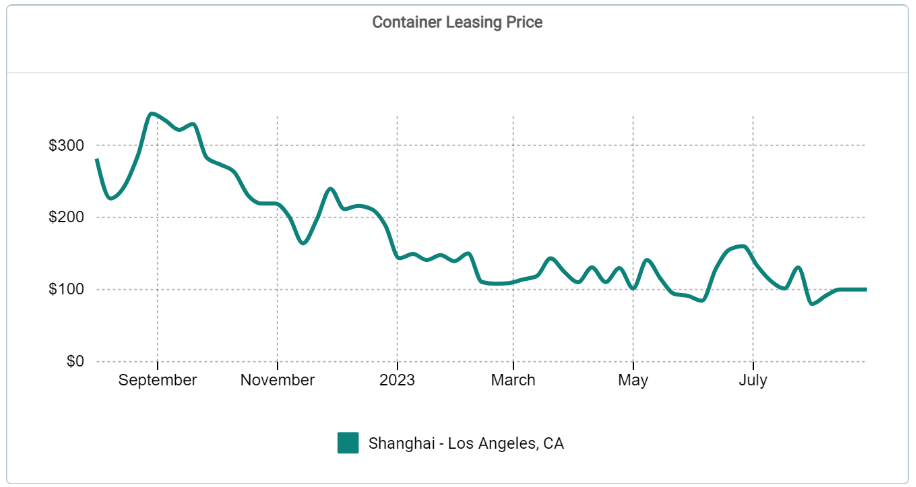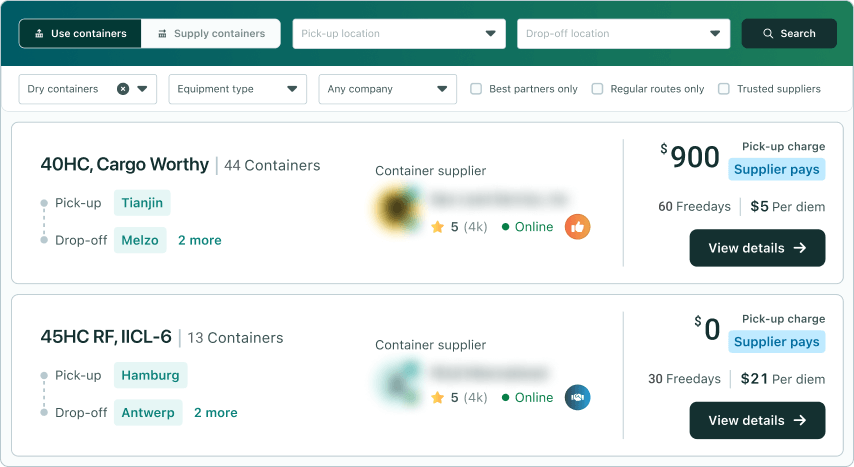Shipping cargo to one of the busiest ports in the US? Get to know all about the largest ports here so you can plan ahead and get the best container leasing rates. Plus, save on port charges by leasing SOCs on Container xChange.
Today, US ports like Los Angeles, New Jersey & New York and Long Beach rank among the top 50 ports in the world in terms of size and shipping traffic. However, sending shipments to these hubs of activity means you’ll be paying higher shipping rates.
Why? With an increase in demand in busy locations, pick-up charges and port fees go up. But don’t fret! We’ve got a solution to keep shipping costs down. Heard of Container xChange?
We’re an online container marketplace for leasing and trading shipping containers in over 2,500+ global locations. On our platform, you can lease SOCs (Shipper Owned Containers) for one-way moves, negotiate pick-up charges directly with partners, and save on certain port charges, all in one place.
Curious to find out more about how Container xChange works? Enter your container requirements into the public search below to see for yourself. Select ‘I want to use containers’ plus the pick-up and drop-off location to find multiple container leasing offers that fit your criteria and budget right now.
Top 10 largest and busiest ports in the US
Before we get into more detail on the busiest ports in the US, here’s an overview of each of these ports in terms of TEUs (Twenty-foot Equivalent Units) handled in 2022 and the percentage difference between 2021 and 2022.
| Port | TEUs handled 2022 | Percentage difference since 2021 |
| Port of Los Angeles | 10,663,636 | -14.59% |
| Port of New Jersey and New York | 9,493,664 | +5.7% |
| Port of Long Beach | 9,133,657 | -2.7% |
| Port of Savannah | 5,892,131 | +8% |
| Port of Norfolk | 3,703,230 | +5.1% |
| Port of Houston | 3,974,901 | +14% |
| Port of Seattle | 3,384,018 | -9.43% |
| Port of Charleston | 2,850,000 | +12% |
| Port of Oakland | 2,337,125 | -4.5% |
| Port of Miami | 1,197,644 | +19,76% |
Now that we’ve got the basic outline, let’s learn more about each port below.
Port of Los Angeles
For the past 22 years, the Port of Los Angeles has been the busiest container port in North America, moving around 10 million cargo containers yearly. The port mainly handles cargo from Transpacific trade. However, Los Angeles port has faced a lot of delays and congestion in the past year. One factor contributing to these hold ups has been the West Coast Port strikes, which only came to an end in July of this year.
Due to these delays, shippers and freight forwarders started to move their shipments to the East Coast. This was in order to avoid paying high leasing rates, as well as to prevent their shipments from getting stuck at ports. So although the port handled over 10 million TEUs in 2022, it’s now experiencing a 26.85% decrease in container volumes in 2023.
Port of New Jersey and New York
The Port of New Jersey & New York makes up the primary port on the East Coast of the US, and is currently the third largest port in the US.
The amount of cargo coming into the Port of New York and New Jersey increased by 5.7% in 2022. This port handles everything from roll-on roll-off (RORO) cargo and break bulk to project cargo. Its six terminals and berths accommodate all container types, as well as the biggest shipping vessels in the industry.
Port of Long Beach
The Port of Long Beach handled 9,133,657 TEUs in 2022, but is seeing a -25.6% decrease in volume this year. This port is popular for its environmentally-friendly operations, making it one of the most sustainable ports in the world. Alongside Los Angeles, Long Beach forms the largest shipping container hub in the US.
The Port of Long Beach has seven terminals and handles 2,000 vessel calls on average per year. The exports at this port include cotton, meat, bulk grain, dairy products, hides, and skins. Imports include beverages, beer/ale/wine, frozen and canned fish, and meat.
Port of Savannah
The Port of Savannah is Georgia’s chief shipping port. If you have shipments to be sent out to Georgia, then this port is the way to go.
There are two terminals here: the Ocean terminal and the Garden City terminal. The Ocean terminal is the main container terminal – and one of the most technologically advanced terminals in the world. The Garden City terminal handles mainly RORO and breakbulk cargo.
The Port of Savannah moved 5,892,131 million TEUs in 2022, growing cargo volumes by 8%, or 432,000 additional TEUs compared to 2021. If this growth continues, the port will surpass the Port of Long Beach as well as the Port of New Jersey & New York.
Port of Norfolk
The Port of Norfolk is located in Virginia. It has a TEU capacity of 3,700,000. This port is made up of three sections: The South Terminal, the North Terminal, and the Central Rail Yard. The port’s largest trading partner is China.
The exports here consist of soybeans, grain products, cereal, flour, bulk grains, and tobacco products. Imports consist of coffee, vodka, bitters, brandy, cognac, vegetables, and nuts.
Port of Houston
The Port of Houston is one of the busiest ports in the US, playing a vital role in international trade. In 2022, Houston port had a TEU capacity of 3,974,901. Some of the major exports of this port include wood, fertilizers, iron, and steel. The primary exports are petroleum, mineral products, oils, and plastics. In terms of imports, there’s palm oil, ethanol, kerosene, juices, milk, and wine.
For those looking to capitalize on this bustling hub, Container xChange offers shipping containers for sale Houston, ensuring you find the best deals and suitable containers for your needs in this major port city.
Port of Seattle
The Port of Seattle works together with the Port of Tacoma. Terminal 86 in the Seattle port is known for its futuristic, automated grain facility. If you need to send out a shipment of grains, rest assured your cargo will be in good hands. Because this terminal is responsible for transferring grains from transport vans to silos. After which, the grains are moved to cargo ships for shipping.
The Port of Tacoma is a deep-water terminal and hence, it can hold large cargo ships. The primary exports leaving these ports are agricultural, while imports range from vehicles and clothes to toys and various kinds of equipment.
Port of Charleston
The Port of Charleston handled 2,850,000 TEUs in the 2022 financial year 2022. If you want to avoid paying tariffs on goods, take note that this port has its own free-trade zone, which distinguishes it from other ports.
All cargo entering and leaving Charleston port can be freely imported and exported because no tariffs are attached to them. The top commodities here include machinery parts, furniture, chemicals and textiles.
Port of Oakland
If you need to send out a shipment to California, opt for the Port of Oakland. It has a TEU capacity of 2,337,125 and is an important port for US agricultural exports. Imports here include electronics, consumer goods, glass, and a variety of household items.
The Oakland port exports dried fruits and nuts, wine, and other beverages.
Port of Miami
Lastly, the Port of Miami handled 1,114,900 TEUs in 2022, making it to our top ten list. Did you know that it’s the only South-Eastern seaport that’s able to house Neo-Panamax vessels? This is because it has the deepest shipping channel of all South-Eastern seaports.
The exports here are grapefruit, citrus fruit juices, poultry, dairy products, bitters, brandy, and cognac. Imports include fruits, vegetables, frozen fish, shrimp, prawns, wine, and vodka.
Before we understand what makes the names mentioned above some of the busiest ports in the US, let’s take a look at a recent unforeseen incident that put the logistics companies into a little scare: the Baltimore Bridge collapse, and how it resulted in the diversion of container flow to some of these busiest ports.
Baltimore Bridge collapse and diversion of container traffic
In the early hours of March 26, 2024, the iconic Francis Scott Key Bridge in Baltimore, Maryland, collapsed after container ship Dali struck it after the ship lost power. As a result, the Port of Baltimore was shut down until further notice.
While firefighting efforts continued to minimize the disruption caused by the collapse, the priority was diverting container flow to other ports originally routed to Baltimore. According to a report by CNBC, some of these alternative ports include New York and New Jersey, Norfolk, Virginia, Georgia, and South Carolina.
What makes these the busiest US ports?
Let’s take a step back from the individual ports and get a quick understanding of what makes these ports so busy.
- Global trade position: For one thing, the US has a lot of influence over global trade due to its power and wealth. The region, as a whole, makes a large amount of transactions through imports and exports each year; no wonder there are so many busy ports here!
- The history of the US: Another factor to take into account is the history of the US. The country has made excellent use of its waterways for centuries. Years ago, there were projects carried out to add more ports to rivers and coastlines, increasing the country’s accessibility and trade flow significantly.
With the increase in imports and exports and the participation in international trade, US ports have become some of the busiest ports in the world.
How do the largest ports in the US impact leasing charges?
Now you know why the ports are so busy, but have you thought about how these ports can affect leasing charges?
Let’s give you an example: you’re planning a shipment from Shanghai, China, to Los Angeles, US. The Port of Los Angeles is extremely busy and has faced serious port congestion and delays this year. As a result, the leasing charges for this port skyrocketed for some time.
To add to this, containers were stuck in ports and terminals past the agreed-upon free days, so shippers had to pay high demurrage and detention (D&D) charges. Sometimes, these charges would add up to more than the container value itself!
To solve this problem, freight forwarders shifted to other ports on the East Coast. By doing this, they were able to get lower container leasing and freight rates. Plus, they effectively managed their logistics operations within the stipulated free days.
To help you understand this better, take a look at the graph below, which we’ve gathered from xChange Insights. Here you can see the pick-up charge trend for 20ft containers going from Shanghai to Los Angeles over the past year (September 2022 to September 2023).

The container leasing rates were more than US $300 back in September last year. But now, due to the decrease in TEUs at the port, the pick-up charges are down to just US $100.
With the help of the graph above, we can conclude that the more TEUs a port handles, the higher its pick-up charges will be.
| Pro tip: You can check out the pick-up charges and free days for SOCs in 180+ locations globally anytime, from anywhere, with our xChange Insights tool. Use Insights to find the cheapest locations to send your shipments to, and save money in the process. The best part? Sign up completely free right now – no strings attached. |
How to find low pick-up rates on routes to the biggest ports in the US?
Ready to find the best pick-up rates to busy ports in the US? Great, we’ll show you how to do this using the Container xChange platform right now.
Before you start searching for leasing offers, we suggest you hop onto xChange Insights to get an idea of the leasing rates along the stretches you need. You can also see the average free days and per diem charges for the stretches you’re interested in.
Once you’ve got an idea of the best leasing rates available, and what you can expect to shell out, it’s time to jump onto the xChange platform.
Tell us your criteria: So you’ve defined your criteria in terms of container type, leasing stretch, and the pick-up charges you’re willing to pay. Great! Now, simply type in your pick-up and drop-off location to start finding available offers that suit you.
Browse leasing offers: Once you’ve typed in your criteria, you’ll get a host of offers that fit your requirements. You can now compare multiple options at the same time to shortlist the one that works best for you. Not sure about a particular supplier? No problem! Check out their reviews and ratings right on the platform.

Negotiate pick-up charges, per diem charges and free days: Once you’ve found an offer you like, it’s time to talk to the supplier to discuss the finer details of the deal. You heard right—chat with suppliers directly on xChange to decide on the final leasing rates, as well as per diem charges and free days. No fuss, no middleman!
Make safe payments: Once the deal is finalized, the only thing that’s left to do is make the payment. If this is the part that usually leaves you sweating, we’re here to put your mind at ease. On xChange you can make all payments directly on the platform using the xChange Wallet. All payments are 100% secure, and you can keep track of all transactions in one place.
Avoid D&D charges on the biggest US ports
One of the best ways to avoid demurrage and detention fees is by leasing shipper-owned containers (SOCs). Simply put, a container is considered a ‘SOC’ when the Beneficial Cargo Owner (BCO), freight forwarder, or NVOCC organizes their own container.
Since you’re sending your shipments to a surplus location (a busy port in the US), using a carrier-owned container (COC) is not beneficial for you. In a busy port, you’ll likely exceed the number of free days set by the carrier. Then, you’ll end up paying high demurrage and detention charges.
Bringing your own container in the form of SOCs allows you to completely avoid paying D&D charges to carriers in the case of delays.
Want to understand this better? Then read our logistics report where we went undercover as freight forwarders to compare SOC and COCs rates. In this report, we’ve given a detailed calculation that you can use as a reference to compare SOC and COC rates for your next shipment.
Lease containers and avoid surcharges on the busiest ports in the US
Ready to ship goods to the busiest US ports at the best rates, plus avoid unnecessary port charges at the same time? With Container xChange, this is finally possible. What’s more, as a member of our platform, you’ll also get:
- 100% market transparency on container leasing rates and trading prices
- Access to 100,000+ container offers in 2,500+ global locations
- A completely safe and secure payment portal with the xChange Wallet
- A chance to negotiate all deals directly with the supplier – cut out the middleman!
Save money and avoid demurrage and detention charges by leasing SOCs for one-way moves today. Click below to get your free demo of our platform and learn more about how our marketplace can work for you. You’ll be getting the best leasing deals on stretches to busy US ports in no time at all.
Busiest ports in the US: Common FAQs
What’s the busiest port in the US?
The busiest shipping port in the US is the Port of Los Angeles, followed closely by the Port of New Jersey & New York.
What are the 5 largest ports in the US?
The five largest ports in the US are the Port of Los Angeles, the Port of Long Beach, the Port of New Jersey & New York, the Port of Savannah, and the Port of Norfolk.
Which are the busiest US East Coast ports?
The busiest ports on the US East Coast are the Port of New Jersey & New York, the Port of Savannah and the Port of Virginia.



